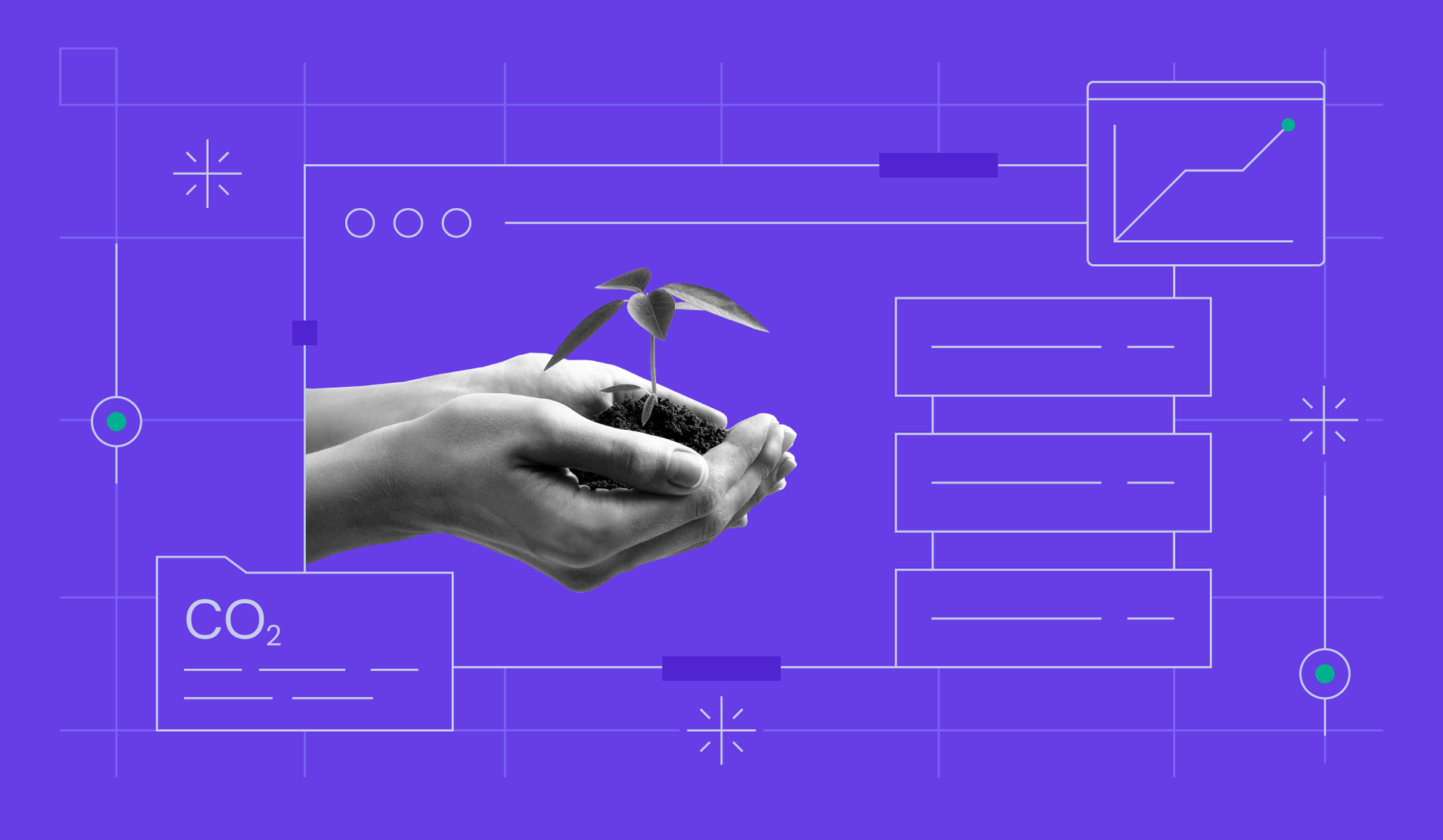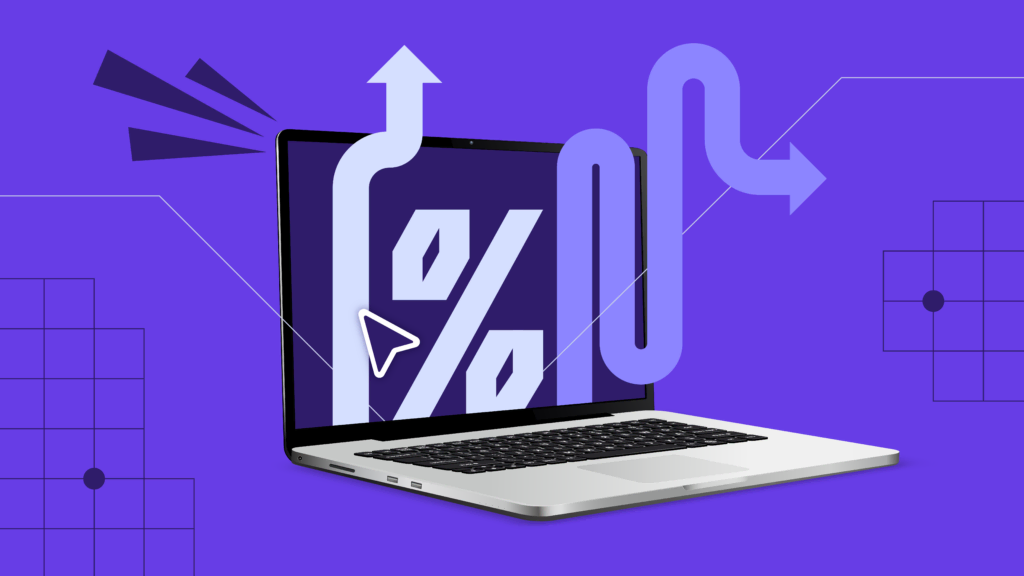Invisible CO2: Websites have a silent carbon impact we’re not talking about

Sustainability has become a hot topic across various industries as people seek greener solutions in every area. From food and fashion to construction, businesses are rethinking their practices to reduce environmental impact and meet rising consumer expectations.
Yet one major industry often escapes the public’s attention – the internet. While most users assume that going digital is eco-friendly by default, the reality is quite different. Every time you open a website, it produces 6.8g CO2 on average – that’s roughly the same as boiling a cup of water.
In this Green Web Report, we’ll explore the digital world’s impact on energy use and carbon emissions. We’ll also dive into the results of our survey of 1,000 internet users in the United States to gauge awareness of this often-overlooked issue.
We hope the survey results and insights will inspire you to be more mindful of the internet and reduce its environmental impact.
The environmental cost of our digital lives: Eye-opening stats
Online communication is part of our daily routine – whether it’s sending funny GIFs, quick ‘thank you’ emails, or sharing moments on social media. These actions feel so natural that we rarely pause to consider their environmental impact.
Add streaming movies, attending virtual conferences, and playing video games online – it’s no surprise that data centers now account for nearly 3% of global energy consumption. While this number might seem small, it is close to the airline industry. In other words, the internet consumes more electricity than the whole United Kingdom.
But data centers are just one part of the system. There’re also:
- Physical infrastructure, like cables and servers.
- Consumer devices, including mobile phones, laptops, and smartwatches.
- Networks, both wired and wireless.
- ICT solutions, which support digital services and applications.
As the use of these devices grows – and new ones continue to emerge – their environmental impact is set to increase. In fact, some experts predict that the internet could account for up to 5.5% of global carbon emissions by 2030.
Rūta Grigaliūnaitė, Sustainability Manager at Hostinger, points out, “While the IT industry has made strides in sustainability, it still lacks comprehensive, widely adopted sustainability practices, benchmarks, and programs. While common goals such as increasing renewable electricity and reducing greenhouse gas emissions are broadly embraced, accurately accounting for customer-related GHG emissions without double counting remains a complex issue, requiring further collaboration. For us, this represents a clear opportunity to make a meaningful impact – and the time to start is now.”
We already have positive examples from leading companies – Google aims to run 100% on renewable energy by 2030, while Amazon targets 2025. For smaller businesses and individuals, the most important step is to start by choosing a green web hosting company for their websites. This way, even small websites can run on renewable resources and produce little to no greenhouse gas emissions.
But before we can make a meaningful change, awareness is essential – people can’t tackle an issue they don’t know exists. To help bridge this gap, we conducted a survey of 1,000 participants to gauge their understanding of the green web.
Website carbon impact awareness: Key findings from our survey
We have surveyed 1,000 respondents from the US about the green web. To maintain objectives, half of the surveyed people (50%) were professionals (website owners and managers), and the rest 50% – regular internet users.
We’ve also made sure to survey a diverse group of participants aged 18 to 56, with varying education levels – ranging from high school graduates to Master’s degree holders – and occupations, including business owners, marketers, web developers, designers, and students.
Be sure to check the full information at the bottom of this article – now, without further ado, let’s dive deep into the results.
Yes, websites have a carbon footprint, and 84.6% of internet users still don’t know about it
The situation among website professionals is equally, if not more, concerning. More than half (63%) of website owners were unaware that their own websites contribute to environmental pollution, highlighting a significant awareness gap even among industry professionals.
This is a very alarming number, as the PwC survey reveals that around 80% of consumers are willing to pay more for brands that are offering sustainable products. This suggests that many potential customers who value sustainability may not even realize they are strongly contributing to global CO2 emissions or that they should prioritize businesses with well-optimized websites that use green web hosting providers.
On the positive side, 38.2% of website professionals view the environmental impact of websites as very important. In contrast, many regular users (34.6%) remain neutral on this issue, highlighting a disconnect in awareness and priorities.

Data centers in the spotlight: The perceived leaders in carbon contribution
Both regular internet users and website professionals agree that data centers are the primary contributors to carbon emissions in the digital world. Generally speaking, this is true, but the actual electricity usage of a data center depends significantly on the types of websites it hosts.
High-traffic platforms with poorly optimized websites can consume far more energy than smaller, greener alternatives, amplifying their environmental impact.
After data centers, both groups identified social media platforms like Facebook and Instagram, as well as streaming services such as Netflix, as significant contributors to carbon emissions. These platforms, known for their massive user bases and continuous content delivery, require extensive server infrastructure to operate, further emphasizing the need for optimized and sustainable web solutions.

Server energy vs website complexity: What people think drives the biggest carbon impact
When it comes to the carbon emissions of websites, 44% of general users and 55.2% of website professionals believe server energy consumption has the most significant impact. This aligns with the common perception that servers powering websites and platforms are the main culprits of digital carbon footprints.
Other factors identified include energy consumption by user devices, cited by 30.6% of general users and 22.8% of website professionals, and data transfers, noted by 18% of general users and 14% of website professionals.
Interestingly, both groups perceive website complexity as having a negligible impact – only 7% of general users and 8% of website professionals attribute emissions to this factor. This indicates that website professionals may underestimate the role of complexity in increasing resource usage, while general users don’t view complex websites as problematic. This lack of awareness could lead to missed opportunities for developers to optimize websites for sustainability.
A blind spot? 73% of website professionals have never measured their website carbon footprint
The widespread perception that website complexity has minimal impact on carbon emissions may explain why nearly ¾ of website professionals have never measured their website’s carbon footprint. This lack of awareness underscores a significant gap in understanding how digital design and optimization can influence environmental sustainability.
Of the few who have measured their website’s carbon impact, just 13.2% did so within the past year, with even fewer assessing it in the last six months (8.6%) or over a year ago (5.2%).
These figures reveal that while some professionals are starting to prioritize sustainability, the majority don’t pay much attention to the environmental impact of their digital presence. This highlights the need for better education and accessible tools to make carbon footprint measurement a standard practice in web development.

Website Carbon Calculator: 24.6% of professionals are already using it
Among website professionals who measure their site’s carbon footprint, Website Carbon Calculator stands out as the most popular tool, used by 24.6% of respondents. This tool’s accessibility and user-friendly interface make it a go-to choice for assessing environmental impact.
Other tools include GreenFrame (4.6%) and GTmetrix (3.4%). These alternatives offer additional features for monitoring energy efficiency and emissions, but their lower adoption suggests a need for greater awareness and education about the variety of tools available for promoting sustainable web practices.

A missed opportunity: 35.1% of website pros haven’t addressed their environmental impact
Over a third (35.1%) of website professionals haven’t yet taken any steps to reduce their website’s carbon footprint, highlighting a significant opportunity for improvement.
Among those who have taken action, around 19% have implemented caching to reduce data transfer, while nearly 18% have focused on compressing images. Additionally, close to 15% have optimized their websites by minimizing JavaScript code, showing that small, targeted measures can contribute to more sustainable web practices.

Now that we know the general awareness level of the website carbon, let’s find out what role sustainable hosting plays to reduce it. We’ll also take a look at how users perceive the concept.
The role of sustainable web hosting: A key step towards renewable resources
Sustainable web hosting is built on several key factors, but the most critical is operating data centers powered by renewable energy. This reduces the environmental footprint of hosting customer websites significantly.
Data centers, which host websites and power the internet, are among the largest energy consumers. Most of their energy usage is dedicated to cooling servers to prevent overheating. Innovative solutions, such as liquid and free cooling systems and renewable energy-powered temperature control, make data centers more environmentally friendly.
To check if your hosting provider is green, you can search for them in the Green Web Directory. Hostinger is proudly listed, thanks to our commitment to renewable energy. In 2023 alone, the share of renewable energy powering our data centers increased by 7%, rising from 35% to 42%. As of October 2024, this number increased to 58%.
Rūta Grigaliūnaitė also points out that, “One of Hostinger’s key initiatives for the upcoming years is to achieve 100% renewable electricity by 2026. This goal includes reaching zero tCO₂e emissions for Scope 1 and 2, as well as developing a Scope 3 reduction plan aligned with the Paris Agreement. To make it easier for our customers to choose data centers powered by renewable electricity, Hostinger clearly highlights renewable options in their hPanel.”
Now, let’s explore how users perceive the importance of sustainable hosting:
Switching to green: 13% of the respondents have already chosen a green web hosting provider
The fact that 13% of respondents have already chosen a green web hosting provider highlights the growing importance of sustainability in the industry. This indicates that eco-friendly hosting isn’t just a niche concern – it’s becoming a competitive advantage. Web hosts risk losing nearly 15% of the market simply by neglecting to prioritize sustainability.
46.2% of web professionals are looking into sustainable hosting providers
Nearly half of website professionals are considering making the switch to a green hosting provider, signaling a positive trend toward sustainability in the web hosting industry. This suggests that the percentage of green hosting users is likely to increase in the near future.
However, 39.2% of website professionals have yet to switch or even consider switching, indicating that there’s still a significant gap in awareness and motivation to prioritize sustainable hosting solutions.
Awareness and cost are the main barriers to reducing website carbon impact
When it comes to making websites greener, 34.43% of website professionals cite a lack of awareness as the primary barrier. Close behind, 33.37% point to cost as their biggest concern, highlighting the perception that sustainable solutions may be expensive.
Additionally, 1 in 5 respondents identify a lack of technical skills as a significant obstacle, emphasizing the need for accessible tools and education in promoting greener web practices.
Did you know? 4 out of 5 website professionals still don’t know about green web hosting
Among web pros, a staggering 68.8% had never heard of the concept of green web hosting before participating in the survey. This highlights a major gap in awareness, even among professionals. Consequently, while adopting green hosting is vital for sustainability, it’s not yet a proven strategy for attracting significantly more website traffic.

Nearly 1 in 3 internet users would support companies with strong environmental practices
Raising awareness is crucial for green web hosting companies, as 28% of internet users say they would definitely support businesses with strong environmental practices. Additionally, an even larger group – 32.8% – indicates they would probably support such companies, underscoring the potential for eco-friendly businesses to gain significant consumer backing.
The green shift: 35.4% of shoppers are inclined to buy from sustainable websites
Following our survey, a third of general users – many of whom were unfamiliar with green hosting before – expressed that they would be more likely to purchase from sustainable websites. This highlights a significant opportunity to raise awareness and tap into the growing consumer preference for eco-friendly businesses.

Powerful strategies to reduce the digital carbon footprint: What you can do
If you have only heard about green website hosting today, here are a few powerful yet easy-to-implement strategies to make your website greener:
- Implement caching – the server will store your website data and load it more quickly. As a result, caching reduces the server load and bandwidth, helping you save energy. We have done various tests with the LiteSpeed cache plugin, improving website performance significantly.
- Compress images – the less your images weigh, the faster they will load, using less energy. Type your website URL into the Tinify Analyzer tool to find out how much you can save by compressing your images.
- Minimize JavaScript – make sure your website code doesn’t contain unnecessary elements, so that it can load faster. Use GTMetrix before and after making a change to see the real impact.
- Enable CDN – our survey on 10,000 websites revealed that enabling a CDN can speed up your website by 40%. In other words, using a CDN can highly reduce your server workload.
Charting the path ahead for the Green Web Movement
Our research shows a significant awareness gap about digital sustainability – many users still don’t know about the environmental impact of websites and how to change that.
With sustainability gaining momentum, now is the perfect time to act. Choose a green hosting provider, ensuring your server runs on renewable energy, and optimize your website to reduce server workload. If you don’t manage a website, support businesses that prioritize eco-friendly hosting by checking where your favorite sites are hosted.
By making these informed choices, you’re not just reducing website carbon emissions – you’re contributing to a global movement toward a greener, more sustainable web.
Survey conducted on October 22 and 24, 2024 by Pollfish for Hostinger through self-administered questionnaire among 1,000 internet users and website professionals residents of the United States between 18 and 56 years old.



